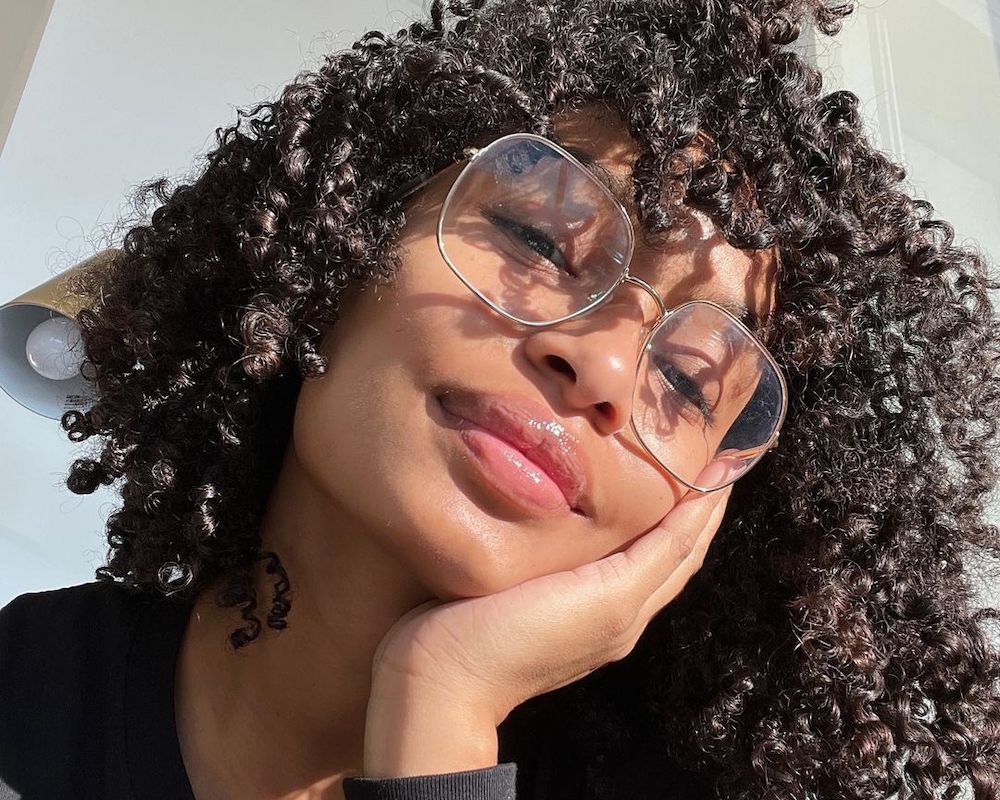Whether you’ve been looking after your curls on your own terms for a while or you’re a total novice when it comes to all things natural hair, identifying your hair type is one of the best things you can do to take your haircare journey to the next level. Once you’ve identified your hair type, you’ll gain a better understanding of its porosity and density, which will ultimately determine how you should care for your curls.
In the hair typing system, curly hair falls under type 3, with subtypes being 3A, 3B, and 3C. Before building the optimal hair care routine, it’s important to remember that each subtype is different. Type 3 hair has a range of curl patterns, with 3C hair having a tight corkscrew structure.
We asked hairstylists Michelle Sultan and Yonkel Chamberlain, as well as trichologist Kari Williams, Ph.D, to help us break down everything there is to know. Keep reading to learn how to identify type 3C hair, the best ways to care for it, and plenty of product recommendations to get you started.
Meet the Expert
- Kari Williams, Ph.D., is a board-certified trichologist and member of DevaCurl’s Expert Curl Council.
- Michelle Sultan is an award-winning celebrity hairdresser, with clients including Jennifer Hudson and Jordyn Woods. She is also an ambassador and creative director for Imbue.
- Yonkel Chamberlain is a hairstylist and the founder of HairPop Lounge.
What Is Type 3C Hair?
“Type 3 hair has a definitive curl that can range from loose curls to springy corkscrews,” Sultan explains. A key characteristic of type 3C is its unique curl pattern: “3C hair is a curly hair type consisting of tight coils with volume and lots of strands packed together to create texture,” Chamberlain says.
Another way to identify this curl type is by its spring factor, “which is dictated by how far your curl stretches when pulled,” Sultan says. If your hair has a spring factor of three to six inches, chances are you have type 3 hair.
Type 3C hair has a defined curl that holds a tight, S-shaped pattern. “3C hair is dense, and most people who have this hair type have curly and coiled strands blended into their hair pattern,” Williams says. According to Sultan, the combination of curls and coils can contribute to this hair type’s thickness and texture. “3C hair is also delicate and susceptible to frizz,” she adds.
Type 3C Hair vs. Other Hair Types
Compared to the rest of the type 3 category, 3C hair has the tightest curl, which tends to loop into corkscrews. “3C hair feels like it has more slip due to its loose and large curl pattern. It’s also shiny and maintains its S-shape curl, even when stretched out,” Chamberlain says. Williams adds that 3C hair differs from the type 4 category because the curls are slightly larger with more definition.
A major difference between 3C and 4A hair is the density. “4A curls consist of springy, S-patterned coils that are about the same circumference as a crochet needle,” Chamberlain says. Although they differ in texture, both 3C and 4A hair types have an S-shape curl, but 4B strands bend in sharp angles resembling the letter Z. As a result, 4B curls are more prone to frizz, which can make it difficult to hold onto protective styles. “Some of the protective styles that tend not to last long for 4B hair types are braid-outs and twist-outs. For a more secure hold, gels and curling lotions will be used to clump strands together and enhance the hair’s curl pattern,” Chamberlain says.
Like type 3C, 4C hair is fragile and prone to dryness. All hair types produce natural oils, but some struggle to move these oils down the shaft. “4C hair is said to experience 75 percent more shrinkage than other hair types,” Chamberlain adds. Unlike with 3C, it can be difficult to discern the zig-zag pattern on 4C hair because of its tight shrinkage.
3C and 4C hair can both be prone to dryness, but with the latter, being mindful of the type of products you use is especially important. “4C hair can easily get overloaded with products if too many heavy oils and butters are used to moisturize it,” Chamberlain says.
How to Care for Type 3C Hair
A variety of practices can help ensure optimum 3C hair health. Before building a routine, 3C hair types may want to understand how porosity levels can influence your optimal care method. “High and low porosity describes how your hair is able to attract and retain water,” Chamberlain says. Low porosity hair types need heat to absorb moisture and should avoid oils and heavy butters “as they will just sit on top of the hair and create product buildup.” High porosity hair is better at attracting moisture but can lose it just as easily, which is why Chamberlain recommends moisturizing with a lotion or leave-in gel. Keep reading for some more expert tips.
- Focus on moisture: Any 3C hair routine should focus on adding moisture, as it’s key to maintaining strong, healthy strands for any hair type, especially curls. “As well as using your preferred hair products for your 3C curls, I also recommend using masks on a weekly basis to attract and retain moisture,” Sultan says.
- Wash your hair regularly: Sultan recommends avoiding sulfates and silicones. Sulfate-free shampoos are a gentler option, especially for those who wash hair frequently or have treated strands. Williams wouldn’t recommend co-washing for type 3C, as “it can have long-term effects on the health of your scalp and the condition of your hair strand.” Alternating co-washing with a regular shampoo can work for some 3C hair types, but if you have low porosity hair, Chamberlain recommends avoiding this practice altogether. “Low porosity hair types need to be clarified on a weekly basis in order for curls to be fresh, bouncy, and defined,” she explains. “For high porosity hair types, 3C curls should be washed in cool or cold water to encourage the pores of the hair to close.”
- Deep-condition your hair: Deep-conditioning 3C curls regularly is a great way to infuse moisture into the strands. “I define deep conditioning as a 15-30 minute process, which incorporates heat or steam with a conditioning product,” Williams says.
- Use a curl cream: Curl creams are great for reducing frizz, adding shine, and enhancing your curls. “I would recommend using products that contain humectants to define the curl pattern, like Imbue’s Curl Empowering Cream Gel. The consistency allows for moisturizing without drying the hair,” Sultan says.
- Use a leave-in conditioner: When finding the right leave-in conditioner for 3C hair, Sultan recommends choosing the formula that fits your moisture needs and preferred style. Check the ingredients for hydrolyzed proteins, as they can cause a slight buildup that may contribute to breakage. “If the leave-in conditioner you want to use contains hydrolyzed proteins, use it as a quick alternative on occasion, but it shouldn’t replace your regular conditioner,” Williams says.
- Handle your curls with care: 3C hair is more fragile than other type 3 curls, so try not to rip through it. “Avoid twisting and pulling the strands because this can cause breakage, but don’t be afraid to run your fingers through your curls,” Williams says. Depending on your experience, 3C hair types may find it easier to detangle when hair is wet.
- Trim hair regularly: All hair types require regular trims to maintain hair health and restore the natural curl pattern. “In addition to trimming hair regularly, all curl pattern types could benefit from a protein hair treatment every six to eight weeks. Protein hair treatments fortify the building blocks of your hair,” Chamberlain adds.
- Preserve your curls: It’s no secret that your nightly hair routine is just as important as how you style it during the day. A satin or silk scarf or bonnet can protect hair overnight, as this helps retain moisture and prevent friction. Simple styling options work well for 3C hair, so try not to over-manipulate strands before bedtime. “I recommend styling hair in large, loose jumbo twists before covering it up,” Williams says. For extra curl protection, Chamberlain and Sultan recommend sleeping on a satin or silk pillowcase, particularly if you don’t have a silk bonnet.
The Best 3C Hairstyles and Cuts
3C hair is quite versatile, so a variety of cuts and styles can work well. Sultan recommends the mullet and curly lion’s mane. “Women and men all over the world with type 3 and 4 hair are opting for this cut—it’s versatile and looks amazing when worn up with bangs out. It celebrates curly hair unapologetically and is a real statement for curl confidence,” she says. Williams recommends bantu knots, topknots, mohawks, bangs, and layered cuts. “As a stylist, it’s important to consider the face shape, lifestyle and current condition of the client’s hair. Styles will also vary based on the density and length of the hair,” she explains.
Growth is an important factor when deciding the best cuts and styles for 3C hair, as this affects the style’s longevity and overall look. “The way your curls are formed is indicative of how the hair follicles are growing from your scalp,” Chamberlain says. “The flatter or more oval-shaped the follicle, the curlier your hair; the more circular the cross-section, the straighter your hair.”
The Best Products for Type 3C Hair
:max_bytes(150000):strip_icc()/imbuecurlempoweringcremegel-22579b8670d441fcb85f949fae2aca93.jpg)
:max_bytes(150000):strip_icc()/imbuecurlenergisinghydrationserum-53f6de0fb7ab421f889f17b3cb7bea7a.jpg)
:max_bytes(150000):strip_icc()/camillerosecurllovemoisturemilk-5d64c545317e4f88af440a915761f018.jpg)
:max_bytes(150000):strip_icc()/auntjackiesfrizzrebel-1fbec071bbd44548970c2c2530082994.jpg)
:max_bytes(150000):strip_icc()/devacurlmeltintomoisturetreatmentmask-8230e14831464919a8e0df8d6452e236.jpg)
:max_bytes(150000):strip_icc()/devacurlmeltintomoisturetreatmentmask-8230e14831464919a8e0df8d6452e236.jpg)
DevaCurl
Melt Into Moisture Treatment Mask
$36.00
A deep conditioning treatment will revive your curls. With a rich, moisture-preserving blend, this mask detangles, smooths, and nourishes dry curls without weighing them down. Silky-soft and shiny curls are just one treatment away: Glide a generous amount through clean, wet hair and leave in for 15-20 minutes before rinsing well. For more intense hydration, cover your curls with a plastic cap while the product sets. Use the mask weekly or as needed.
14 Secrets to Styling Naturally Curly Hair










